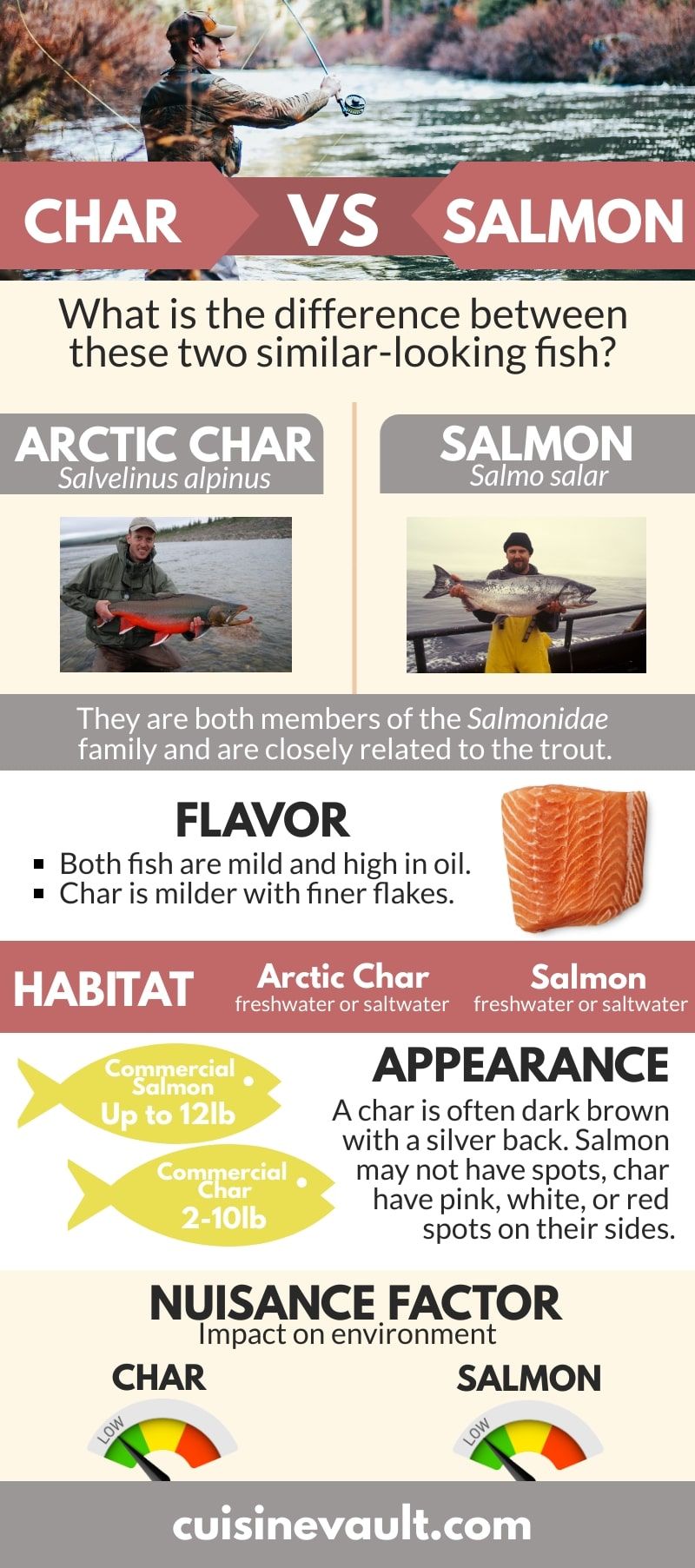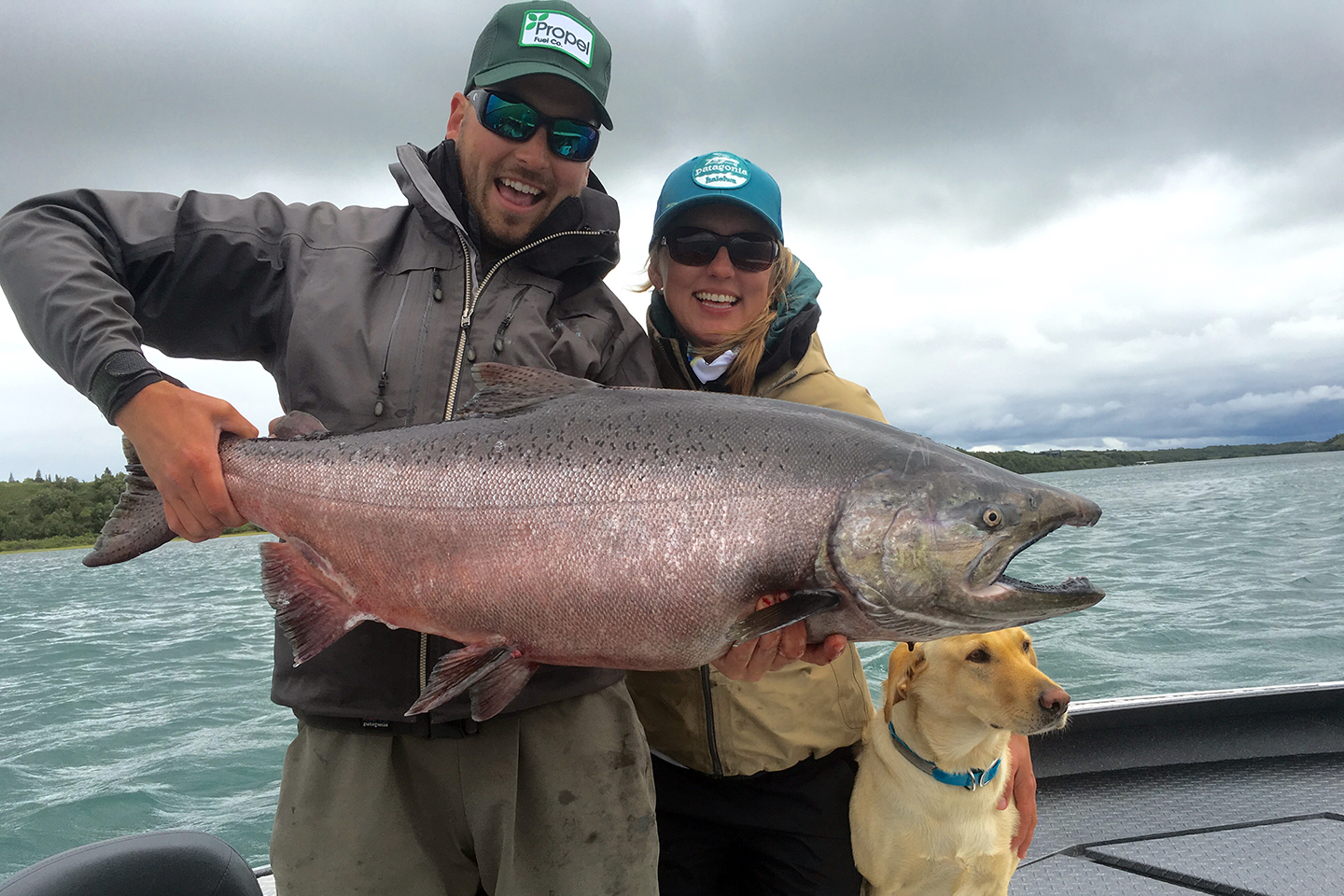Introduction

Arctic char and salmon are two coldwater fish varieties that are widely consumed globally. Although they share similarities in terms of flavor and nutritional value, there are distinct differences that set them apart. In this article, we will explore these differences and provide an overview of both Arctic char and salmon. We will also delve into their habitat, distribution, and migration patterns, as well as discuss the nutritional benefits they offer. Additionally, we will examine the best cooking methods for each fish and provide delicious recipe suggestions. By the end, you’ll have a better understanding of Arctic char and salmon and be able to make an informed choice when choosing between the two.
Introduction To Arctic Char And Salmon
Arctic char and salmon are two cold-water fish varieties that have gained popularity worldwide due to their delicious flavor and nutritional benefits. Both belong to the Salmonidae family and thrive in cold, pristine waters. Arctic char is known for its vibrant pink flesh and delicate texture, while salmon is recognized for its rich flavor and firm, flaky flesh. These fish are highly valued both for their culinary uses and as a sustainable source of protein. Understanding the distinct characteristics of Arctic char and salmon is essential for appreciating their unique qualities and making informed choices when consuming or cooking with them.
Differences Between Arctic Char And Salmon
Arctic char and salmon may seem similar at first glance, but there are several key differences between these coldwater fish varieties.
- Appearance: Arctic char typically has a lighter, more vibrant pink or red flesh, while salmon has a deeper orange hue. Arctic char also has a lighter, silvery skin compared to the darker skin of salmon.
- Texture: Arctic char has a delicate texture, while salmon has a firmer texture. The flesh of Arctic char is finer and softer, while salmon has a slightly coarser and denser texture.
- Flavor: Arctic char has a mild, delicate flavor with subtle hints of sweetness. Salmon, on the other hand, has a richer, stronger flavor with more pronounced umami notes.
- Habitat and Distribution: Arctic char is primarily found in cold, freshwater environments such as rivers and lakes in the Arctic regions, while salmon is known for its migrations between freshwater and saltwater habitats.
Understanding these differences can help in choosing the right fish for specific culinary preparations and personal preferences.
Arctic Char Overview

Arctic Char is a coldwater fish species that is highly valued for its delicate flavor and texture. It is closely related to salmon and trout and shares some similarities with both. Arctic Char has a lighter, silvery skin and a vibrant pink or red flesh. This fish is primarily found in cold, freshwater environments such as rivers and lakes in the Arctic regions. It is known for its resilience in harsh conditions and its ability to thrive in cold waters. Arctic Char is highly sought after for its nutritional value, as it is rich in omega-3 fatty acids and other essential nutrients.
Arctic Char Habitat And Distribution
Arctic Char are primarily found in cold, freshwater habitats throughout the northern hemisphere, including the Arctic, subarctic, and alpine regions. They are well adapted to thrive in extreme cold environments and can be found in lakes, rivers, and even coastal waters. Arctic Char are known to inhabit both deep and shallow waters, depending on the season and availability of food. Their distribution ranges from Canada, Alaska, and Greenland to parts of Scandinavia, Russia, and even into the high-altitude lakes of the Rocky Mountains. This wide distribution reflects their ability to adapt to different coldwater habitats.
Arctic Char Nutrition And Flavor Profile
Arctic Char is not only delicious but also offers notable nutritional benefits. It is a good source of high-quality protein, omega-3 fatty acids, and essential vitamins and minerals. The fish is known for its rich, buttery flavor and flaky texture, which can be compared to a combination of trout and salmon. The omega-3 fatty acids found in Arctic Char help promote heart health and reduce inflammation in the body. Its mild flavor profile makes it versatile in various culinary preparations, making it a popular choice for seafood lovers.
Salmon Overview

Salmon is a diverse and highly sought-after species of fish known for its vibrant color, rich flavor, and abundant health benefits. There are several species and varieties of salmon, including Chinook (King), Sockeye (Red), Coho (Silver), and Atlantic salmon. They inhabit both freshwater rivers and the open ocean, with some species migrating thousands of miles to spawn. Salmon have a unique life cycle, beginning in freshwater where they hatch, gradually migrating to the ocean, and returning to their birthplace to reproduce. This cycle contributes to their distinct flavor and texture. Salmon is not only delicious but also packed with omega-3 fatty acids, vitamins, and minerals, making it an excellent addition to a healthy diet.
Salmon Species And Varieties
There are several species and varieties of salmon, each with its own unique characteristics. Some of the most well-known ones include Chinook (also known as King salmon), Sockeye (commonly referred to as Red salmon), Coho (often called Silver salmon), and Atlantic salmon. Chinook salmon is the largest of the species, known for its rich, buttery flavor. Sockeye salmon has a vibrant red flesh and a strong, robust flavor. Coho salmon has a milder taste and a delicate texture. Atlantic salmon, while not as commonly found in the wild, is a popular choice in aquaculture. Each species offers a slightly different culinary experience, allowing for a variety of flavors and textures to suit different preferences.
Salmon Migration Patterns And Life Cycle
Salmon are known for their remarkable migration patterns and complex life cycle. After hatching from eggs in freshwater rivers and streams, young salmon called fry make their way downstream to the ocean. Once in the ocean, they spend several years maturing and growing in nutrient-rich waters. When it’s time to spawn, adult salmon undertake an arduous journey upstream, swimming against strong currents and leaping over obstacles to reach their natal streams. This incredible instinctual behavior allows salmon to reproduce and continue their life cycle, ensuring the survival of the species.
Health Benefits Comparison

When it comes to health benefits, both Arctic char and salmon have unique advantages. Both fish are rich in omega-3 fatty acids, which have been linked to various health benefits, including heart health and brain function. Additionally, they are excellent sources of high-quality protein and essential nutrients such as vitamin D, vitamin B12, and selenium. The consumption of these fish can promote healthy skin, support immune function, and contribute to overall well-being. Incorporating Arctic char or salmon into your diet can be a delicious way to boost your nutrient intake and support a healthy lifestyle.
Nutritional Value Of Arctic Char Vs Salmon
Arctic char and salmon are both highly nutritious fish, offering a range of health benefits. In terms of their nutritional value, they are similar in many ways. Both fish are excellent sources of omega-3 fatty acids, which are known to promote heart health and brain function. They are also rich in high-quality protein and essential nutrients such as vitamin D, vitamin B12, and selenium. Incorporating Arctic char or salmon into your diet provides a well-rounded nutritional profile, supporting overall well-being and contributing to a healthy lifestyle.
Health Benefits Of Consuming Arctic Char And Salmon
Arctic char and salmon offer a wide range of health benefits when included in a balanced diet. Both fish are excellent sources of omega-3 fatty acids, which have been linked to reduced inflammation, improved heart health, and enhanced brain function. These fatty acids also play a crucial role in maintaining healthy skin and hair. Additionally, Arctic char and salmon are rich in high-quality protein, which is essential for muscle growth and repair. They also provide important nutrients such as vitamin D, vitamin B12, and selenium, which support overall health and wellbeing. Regular consumption of Arctic char and salmon can contribute to a healthy lifestyle and help meet nutritional needs.
Cooking And Preparation

When it comes to cooking and preparation, both Arctic char and salmon offer a range of delicious possibilities. Arctic char’s delicate flavor makes it perfect for simple preparations like grilling or pan-searing. On the other hand, salmon’s robust flavor and firmer texture make it a popular choice for smoking, curing, and grilling. It is also commonly used in sushi and sashimi dishes. No matter how you choose to cook them, both fish can be enjoyed in various flavorful recipes. From elegant grilled fillets to hearty smoked salmon salads, the options are endless for creating mouthwatering dishes with these coldwater fish.
Best Cooking Methods For Arctic Char And Salmon
When it comes to cooking Arctic char and salmon, there are a variety of methods that can enhance their flavors and textures. Here are some of the best cooking methods for these coldwater fish:
- Grilling: Both Arctic char and salmon are delicious when grilled. The high heat helps to caramelize the natural sugars in the fish, resulting in a flavorful and slightly crispy exterior.
- Pan-searing: Pan-searing is another great option for these fish. Heat a little oil in a skillet and cook the fillets for a few minutes on each side until they are crispy on the outside and tender on the inside.
- Baking: Baking is a gentle cooking method that allows the fish to retain its moisture. Place the fillets on a baking sheet, season them with herbs and spices, and bake them in a preheated oven until they are cooked through.
- Poaching: Poaching is a delicate method that involves gently simmering the fish in liquid. This helps to keep the fish moist and tender. You can poach Arctic char and salmon in broth, wine, or a mixture of water and lemon juice.
- Smoking: Smoking is a popular method for both Arctic char and salmon. It adds a smoky flavor and creates a deliciously flaky texture. You can use a smoker or even a stovetop smoker to achieve that perfect smoky taste.
No matter which cooking method you choose, it’s important to not overcook the fish. Both Arctic char and salmon are best when they are still slightly pink and moist on the inside. So, keep a close eye on them while cooking to ensure the perfect result.
Recipes And Serving Suggestions
Arctic char and salmon can be prepared in a variety of delicious ways. For a simple and elegant meal, try pan-searing arctic char fillets and serving them with a lemon-dill sauce. For salmon, a classic recipe is to bake it with a honey mustard glaze for a sweet and tangy flavor. Another option is to smoke either fish and serve it on a bed of mixed greens with a citrus vinaigrette. For a light and refreshing dish, try making a salmon or arctic char ceviche with lime juice, diced tomatoes, and fresh herbs. These recipes and serving suggestions will surely impress your guests and highlight the flavors of these delicious coldwater fish.
Conclusion

In conclusion, Arctic char and salmon are both delicious and nutritious coldwater fish options. While Arctic char offers a milder and delicate flavor, salmon provides a richer and oilier taste. They also differ in terms of their appearance, with Arctic char featuring light pink, white, or red spots, while salmon has darker brown or green spots. When it comes to health benefits, both fish are packed with essential nutrients and omega-3 fatty acids. Ultimately, the choice between Arctic char and salmon comes down to personal preference and the desired flavor profile for your meals.
Key Takeaways From Comparing Arctic Char And Salmon
When comparing Arctic char and salmon, there are a few key takeaways to keep in mind. Firstly, Arctic char has a milder and delicate flavor, while salmon offers a richer and oilier taste. Secondly, their appearance differs, with Arctic char having light pink or red spots, and salmon featuring darker brown or green spots. Lastly, both fish are nutritious options packed with essential nutrients and omega-3 fatty acids. Ultimately, the choice between Arctic char and salmon comes down to personal preference and desired flavor profile for your meals.
Tips For Choosing Between Arctic Char And Salmon
When choosing between Arctic char and salmon, there are a few tips to consider. Firstly, think about your desired flavor profile. If you prefer a milder and delicate taste, Arctic char is the way to go. On the other hand, if you enjoy a richer and oilier flavor, salmon is the better choice. Secondly, consider your cooking method. If you want a fish that holds up well to grilling or smoking, salmon is the preferred option. Lastly, take into account the availability and sustainability of the fish in your area. Opt for a fish that is locally sourced and sustainably harvested for a more eco-friendly choice.
FAQ About Arctic Char Vs Salmon: Comparing Coldwater Fish Varieties
Q: What is the main difference between Arctic Char and Salmon?
A: The main difference is their habitat; Arctic Char thrive in cold, freshwater lakes and rivers in the Arctic and subarctic regions, while Salmon are anadromous fish that are born in freshwater, migrate to the ocean, and return to rivers to spawn.
Q: How do the flavors of Arctic Char and Salmon compare?
A: Arctic Char is often described as milder and less fishy compared to Salmon, which has a stronger, richer flavor. Arctic Char’s taste is likened to a mix of Salmon and Trout.
Q: Are there nutritional differences between Arctic Char and Salmon?
A: Both are excellent sources of protein and healthy omega-3 fatty acids. Arctic Char tends to have slightly fewer calories and fat content, but both are nutritious choices for a balanced diet.
Q: Which fish is more sustainable to consume, Arctic Char or Salmon?
A: Arctic Char is generally considered a more sustainable choice compared to certain types of mainstream Salmon, as Char populations are not as heavily harvested, and they are often farmed in more environmentally friendly conditions.
Q: Can Arctic Char be prepared and cooked in the same way as Salmon?
A: Yes, Arctic Char can be cooked similarly to Salmon. It can be grilled, baked, poached, or pan-seared, and its versatility allows for a variety of seasonings and preparations just like Salmon.
Q: Are there any health considerations when choosing between Arctic Char and Salmon?
A: Both are nutritious options, but individuals with specific dietary restrictions or health conditions should consult with a healthcare provider to determine the best choice based on their needs.

Welcome to Braddock Bay Tavern & Grill, where history, delicious cuisine, and stunning views come together to create an unforgettable experience. Our restaurant, situated on the picturesque edge of Lake Ontario, has a rich history that adds a unique charm to your dining experience. The roots of our establishment can be traced back to 1865, when it was first constructed as an icehouse. Over the years, it transformed into the historic Braddock Bay Hotel, becoming a beloved local landmark. Today, we take pride in preserving the building’s historical beauty, ensuring that every visit to our restaurant is a journey through time.